There’s no doubt that Hyundai has emerged as one of the leaders in electrification. It quietly got there thanks to vehicles like the Kona Electric, one of the first long-range battery-electric vehicles on the market. This subcompact crossover was secretly in the 300-mile club before vehicles like the Volkswagen ID.4 and Ford Mustang Mach-E even made headlines. The refreshed 2022 Hyundai Kona Electric adds the latest technologies and a new look to an already compelling package but will that be enough?
2022 Hyundai Kona Electric exterior
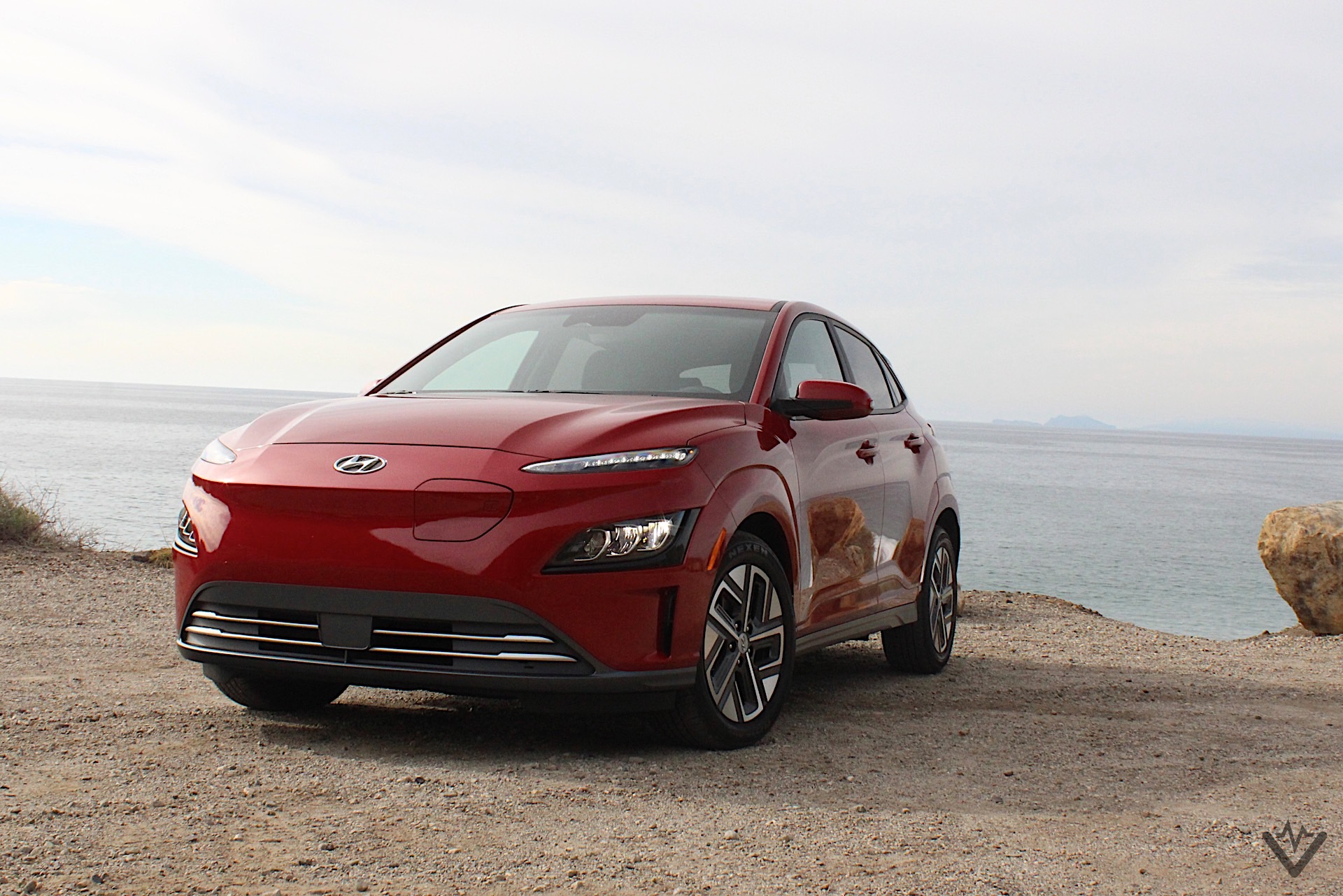
Hyundai’s mid-cycle refreshes are among the most extensive and it’s most apparent in their crossover lineup. The 2022 Hyundai Kona Electric looks distinct from the pre-refresh iteration because it has a cleaner, more streamlined front fascia. The geometric pattern and chrome mustache-like strip are gone and the main headlight clusters have been reshaped with softer lines. In the back, the housing for the rear turn signals and reverse lights mimic the shape of the main headlights. Fresh 17-inch alloy wheels that improve the crossover’s aerodynamics have also been added.
2022 Hyundai Kona Electric interior
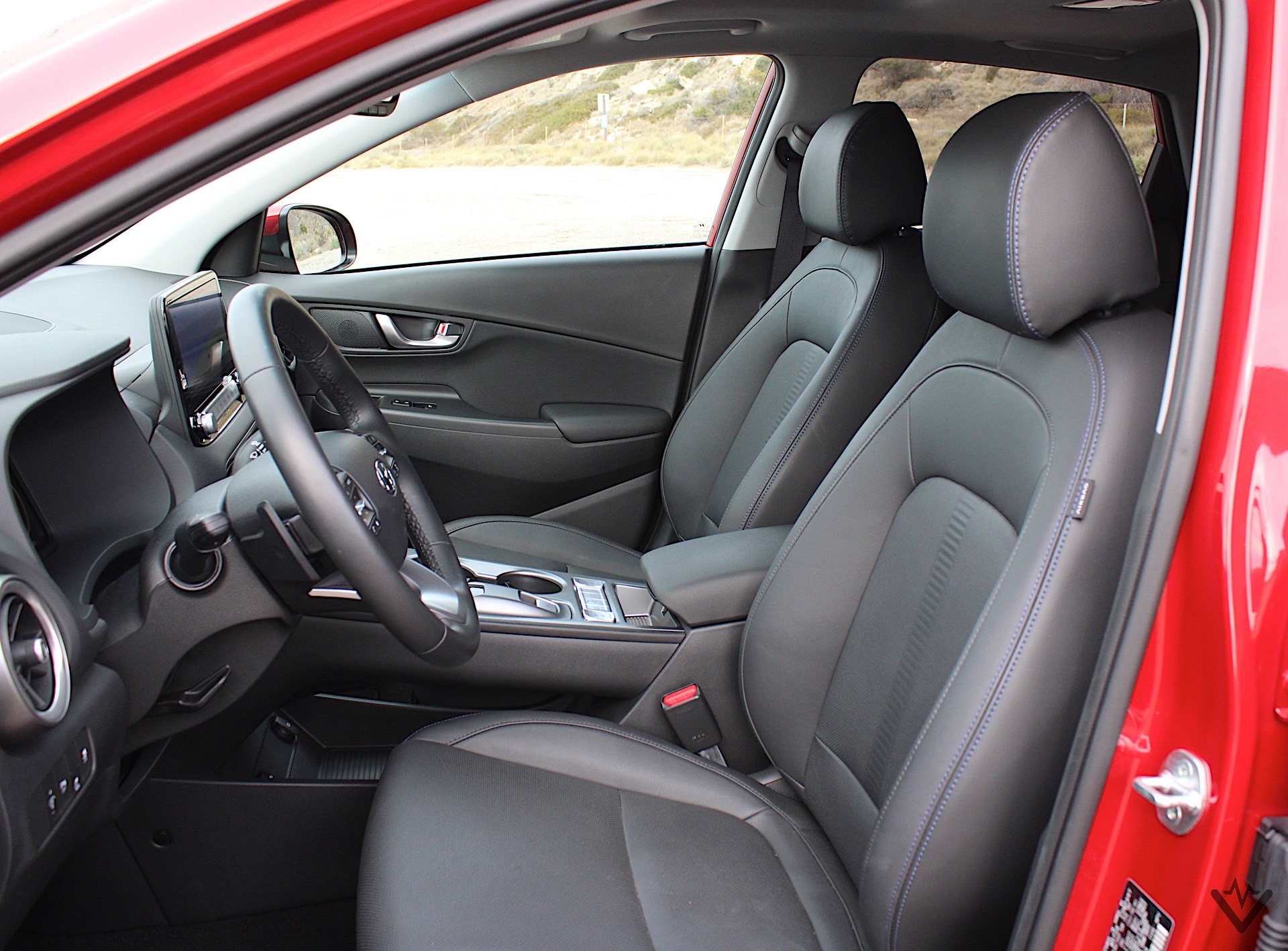
The first thing you’ll notice inside the Kona Electric is the crossover’s narrowness because occupants are pretty close to each other. Average-sized adults will be fine in front since head and legroom are generous. The seats are also comfortable yet supportive with good bolstering. Keep it to two in the rear seats because space is limited back there. Due to the battery being under the passenger cabin, the floor is raised slightly; this is most noticeable in the second row where your legs are at an odd angle.
Cargo capacity is at a premium regardless of whether you have the rear seats up or down. Although you have a flat load floor and good vertical space, the Kona Electric’s tidy dimensions limit overall capacity. Since it has an electronic gear selector, there’s enough space under the center console for a small bag. The front cubby fits most smartphones without a cord and has a ventilated wireless charging pad. Both the center console bin and glovebox are also sizable, allowing them to accommodate more knickknacks. There’s also a slot in the back of the center console for your phone and it’s conveniently located next to a USB charging port.
In terms of the fit and finish, the Kona Electric falls squarely in the mainstream realm. The materials used have good textures and feel sturdy. Most touch points are padded or soft but surrounding them are lots of hard plastic. Thankfully, they don’t exude a sensation of chintziness and the cheaper bits are mostly kept away from areas you touch frequently. Unfortunately, the Kona Electric’s cabin needs additional sound insulation. There’s a good amount of exterior noise entering the cabin, particularly wind buffeting and tire roar, at highway speeds.
2022 Hyundai Kona Electric tech features
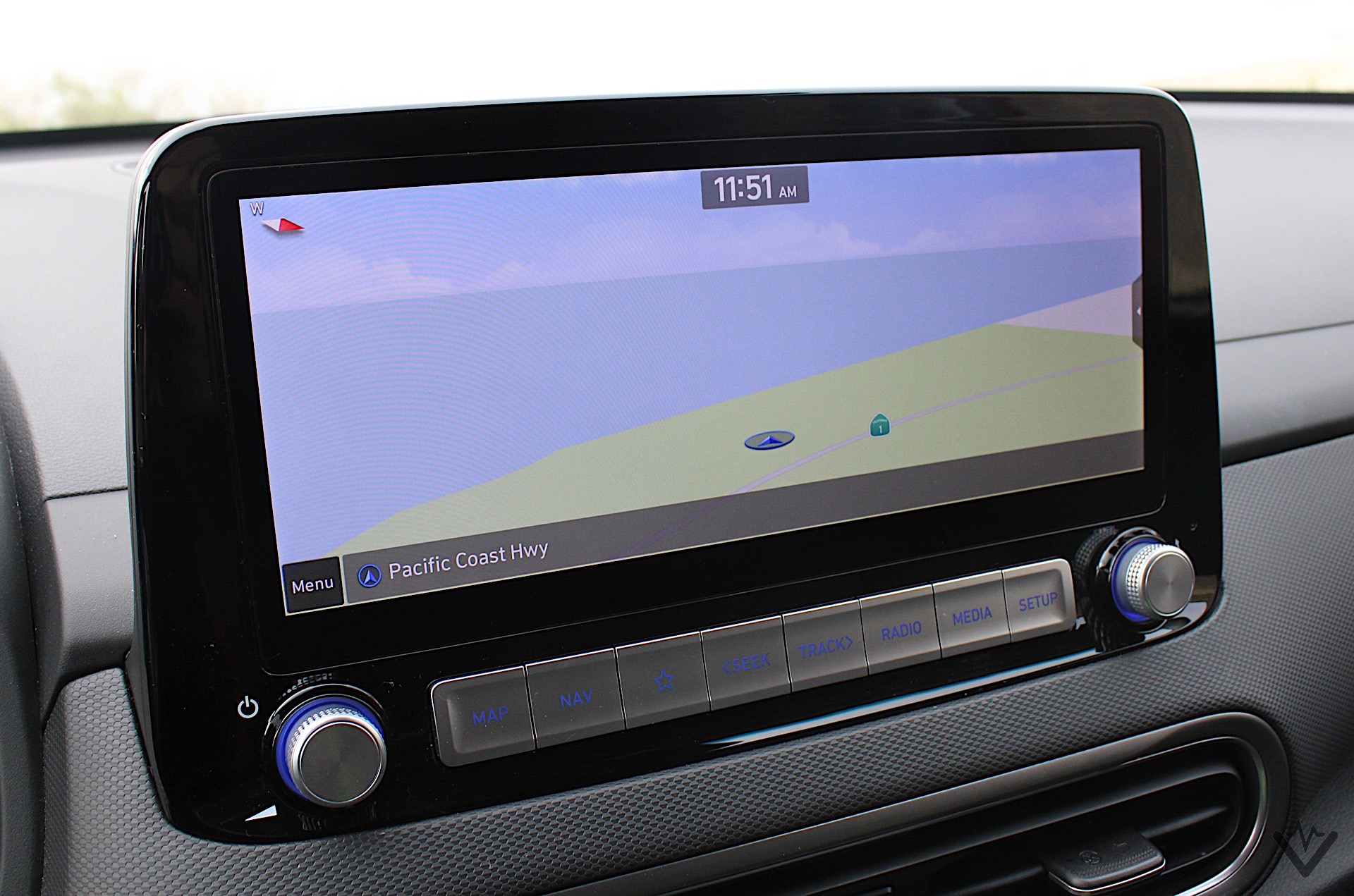
For the 2022 refresh, the Kona Electric gets the latest version of Hyundai’s infotainment system. Our range-topping Limited test car came with a 10.25-inch digital gauge cluster and a similarly-sized main touch screen, both of which are user-friendly, intuitive, and responsive. There are physical shortcut buttons below the main display and conventional volume and tuning knobs, keeping the controls familiar. The center stack controls mimic that of the Nexo fuel-cell crossover, giving it a modern look without sacrificing usability. An eight-speaker Harman Kardon audio system plays your tunes clearly; however, it could do a better job enveloping the cabin.
Hyundai’s SmartSense driver assistance suite is standard on all Kona Electric models. Certain features like cyclist detection, automatic high beams, and the Highway Driving Assist semi-autonomous system are only on the Limited trim. The collision prevention components do a great job of keeping you away from other vehicles and centering you in your lane without becoming jerky. Highway Driving Assist seamlessly follows traffic but its distancing component could be better calibrated because it’s late to detect slower traffic ahead. We recommend setting it to level 2 or higher so that it responds to changing road conditions early.
2022 Hyundai Kona Electric driving impressions
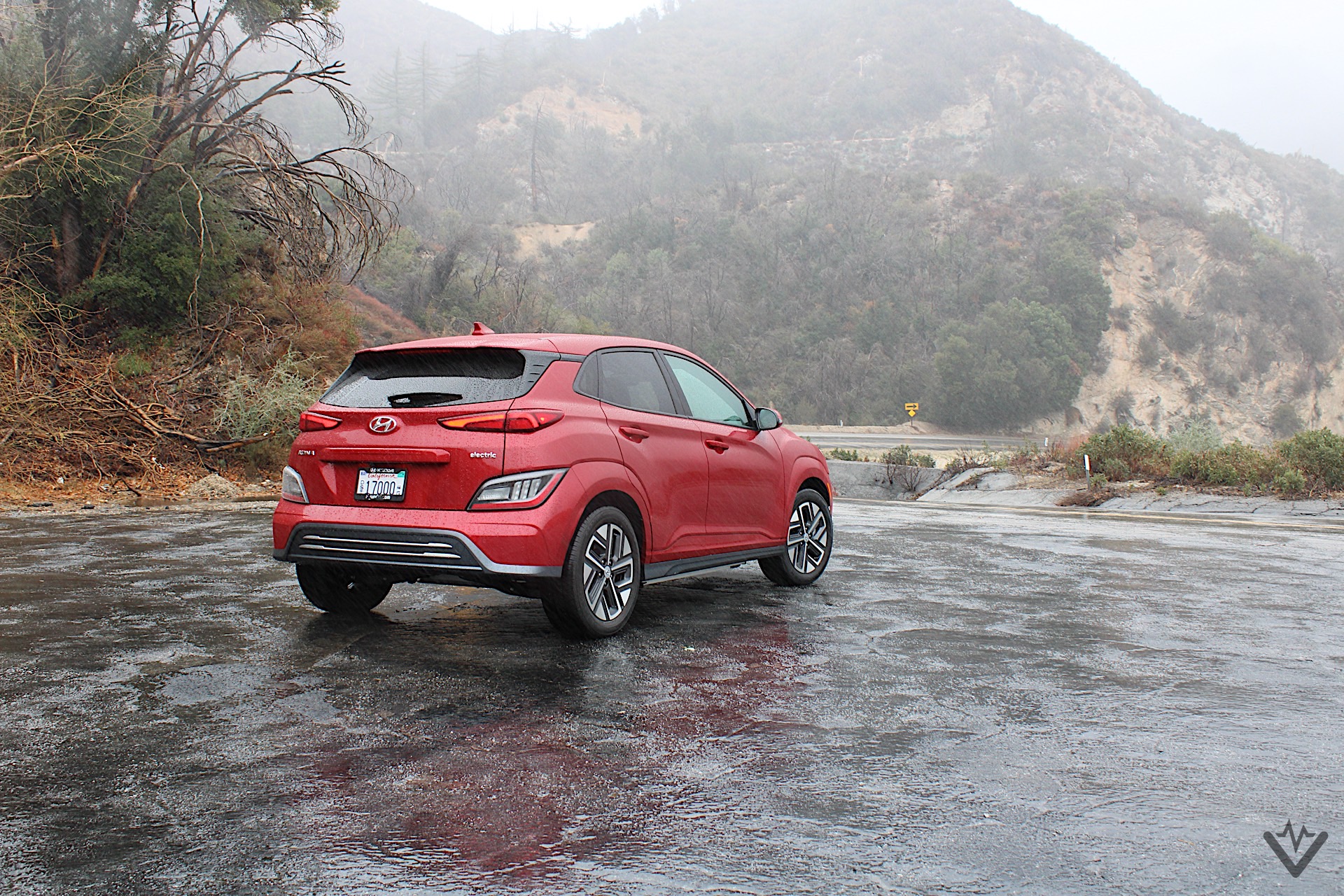
Like its internal combustion counterpart, the Hyundai Kona Electric is among the best driving subcompact crossovers. The powertrain amplifies that thanks to the electric motor delivering 201 hp and 291 lb-ft of torque instantly. That means there’s no waiting for power to build up; allowing you to effortlessly pass Sunday drivers, climb steep inclines, and get up to freeway speeds by simply mashing on the accelerator. Beware of the eco-focused tires though because you’ll spin them endlessly if you don’t ease into the throttle gently, especially from a standstill. AWD would’ve added more traction but possibly at the cost of the overall driving range, which is likely the reason why Hyundai kept the all-electric Kona FWD only.
Complementing the punchy powertrain is a finely balanced chassis that gives the Kona Electric great road manners. It changes directions willingly and takes turns enthusiastically, making it feel like a slightly lifted hot hatch. With the 64-kWh battery mounted under the passenger compartment, the Kona Electric possesses a low center of gravity, resulting in minimal body motions. Together with its quick, communicative steering, the Kona Electric is a joy to toss into corners. Stickier rubber would complete the package because the suspension, chassis, and powertrain easily overwhelm the low rolling resistance tires.
There are four drive modes on the Kona Electric: Eco, Normal, Sport, and Eco+. Each one is distinct but the best part is that neither Eco nor Eco+ mode dulls the throttle response too much. That means they’re viable to use daily and won’t make the car feel lethargic when you ask for more power. Normal mode gives the crossover a smooth driving feel thanks to linear power delivery. Sport mode, livens up the Kona Electric’s character, sharpening its reactions to your throttle inputs and tightening the steering.
The Kona Electric’s agility doesn’t come at the cost of compliance. Like AWD variants and the performance-minded Kona N, the all-electric version gets independent suspension in all four corners. Yes, it’s on the stiff side but the crossover still does a good job keeping harsh impacts out of the passenger compartment. Credit the tires with generous sidewall for keeping the Kona Electric compliant over poorly maintained roads.
Quite possibly the biggest hint that the Kona Electric is one of the older EVs on the market is its brake operation. Transitions from regenerative to mechanical braking aren’t linear, sometimes resulting in sudden jerkiness when slowing down or executing an emergency stop. You can alleviate this by putting the four-level regenerative braking in its strongest setting. This provides better control of your speed, allowing you to slow down gradually as you ease off the accelerator. By the time you start pressing the brake pedal, you’ll be slow enough that you avoid getting jerked around. One-pedal driving is available in the Kona Electric but you need to hold the left paddle shifter to initiate it. Letting go of it, however, will cancel it and won’t bring you down to a complete stop.
The EPA rates the Hyundai Kona Electric at 258 miles per charge but we found those numbers to be conservative. A quick trip up the Pacific coast Highway to Camarillo, California, and out to Palm Springs revealed that this thing easily breaks the 300-mile mark. Over a week’s worth of driving, we averaged 4.8 miles per kWh. Even when we weren’t driving with efficiency in mind, the car still managed to average above 4.0 miles per kWh.
Using a DC charger, the Kona Electric can charge from 10 to 80 percent in around 47 minutes at peak rates of 100 kW. Less powerful 50 kW chargers increase the charging time to 64 minutes. Thanks to the crossover’s 7.2-kW onboard charger, it can get a full charge in 9 hours and 15 minutes via a level 2 AC charger or 240-volt outlet.
2022 Hyundai Kona Electric pricing
The 2022 Hyundai Kona Electric starts at $35,185 for the base SEL grade. Our range-topping Limited test car with the accessory floor mats cost $43,880. Every Kona Electric model is eligible for the full $7,500 federal tax credit plus local and state incentives.
2022 Hyundai Kona Electric final verdict
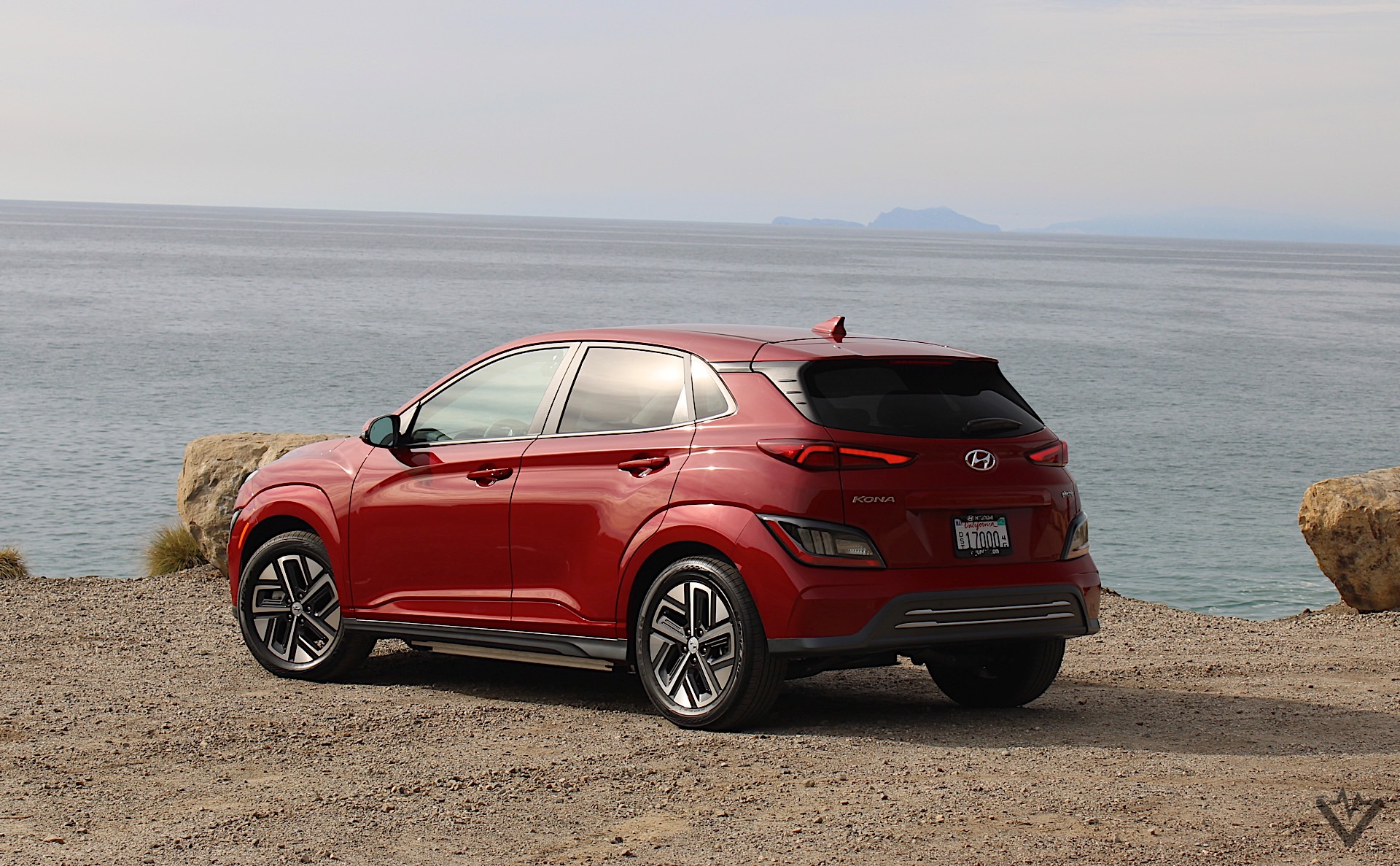
Although it’s no longer the newest EV on the block, the 2022 Hyundai Kona Electric remains a compelling offering because it’s so well-rounded. It goes far on a single charge, drives well, and has intuitive technologies. If its size works for you, the Kona Electric is one of the best affordable EVs on the market. Sure, it doesn’t charge as quickly as newer EVs but its price tops out lower, retaining the strong value proposition. Simply put, the Hyundai Kona Electric is a lot for the money because it possesses so much content and substance.
At a glance
- Year: 2022
- Make: Hyundai
- Model: Kona Electric
- Trim: Limited
- Type: 4-door subcompact crossover
- Horsepower: 201
- Torque: 291 lb-ft
- Combined MPGe rating: 120
- Range: 258 miles
- Pros: Long range, good ride and handling, quick acceleration
- Cons: Noisy interior, small interior, DC charges only up to 100 kW
- Base price: $35,185
- Price as tested: $43,880
